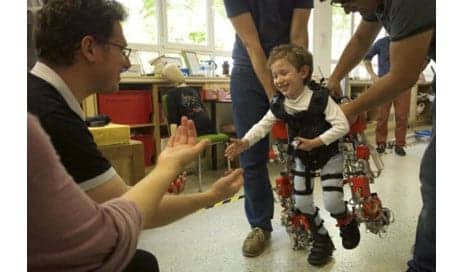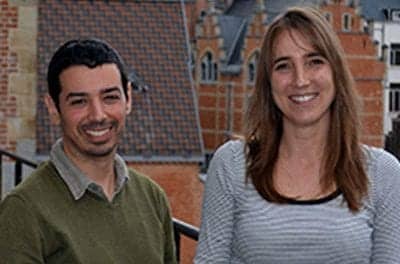
Five-year-old Álvaro, who suffers from spinal muscular atrophy, walks toward his parents during an exoskeleton test. (Photo courtesy of Joan Costa – CSIC)
The exoskeleton, made from aluminum and titanium, is designed to help children with spinal muscular atrophy walk—in some cases, for the first time.
In addition, notes a media release from the Spanish National Research Council (CSIC), the exoskeleton will be used during physiotherapy sessions in hospitals to help prevent the secondary effects associated with the loss of mobility in spinal muscular atrophy patients.
The exoskeleton consists of long support rods, or orthoses, which are adjusted to fit around the child’s legs and torso. In the joints, a series of motors mimic human muscles and give the child the necessary strength to stand upright and walk. Other components include a series of sensors, a movement controller, and a battery with 5 hours of life, per the release.
Children between the ages of 3 and 14 are the target users of this brace.
With five motors in each leg (each requiring its own space to function), the minimum possible length of each leg is restricted. Furthermore, the unpredictability of the involuntary body movements of under-3s have forced researchers to set a lower age limit for the device, the release notes.
“The number one drawback in developing this type of paediatric exoskeleton is that the symptoms of neuromuscular illnesses- such as spinal muscular atrophy- change over time, as much in the articulations as in the body. That’s why it’s fundamental to have an exoskeleton capable of independently adapting to these changes,” explains Elena Garcia, from the Automatics and Robotics Centre, a CSIC/Politechnic University of Madrid, in the release.
“Our model includes intelligent joints which alter the brace’s rigidity automatically and adapt to the symptoms of each individual child at whenever required,” she adds.
The exoskeleton technology has been patented and licensed jointly by CSIC and its technology-based business unit, Marsi Bionics, and is currently in the preclinical phase, per the release.
[Source(s): Spanish National Research Council, Science Daily]



